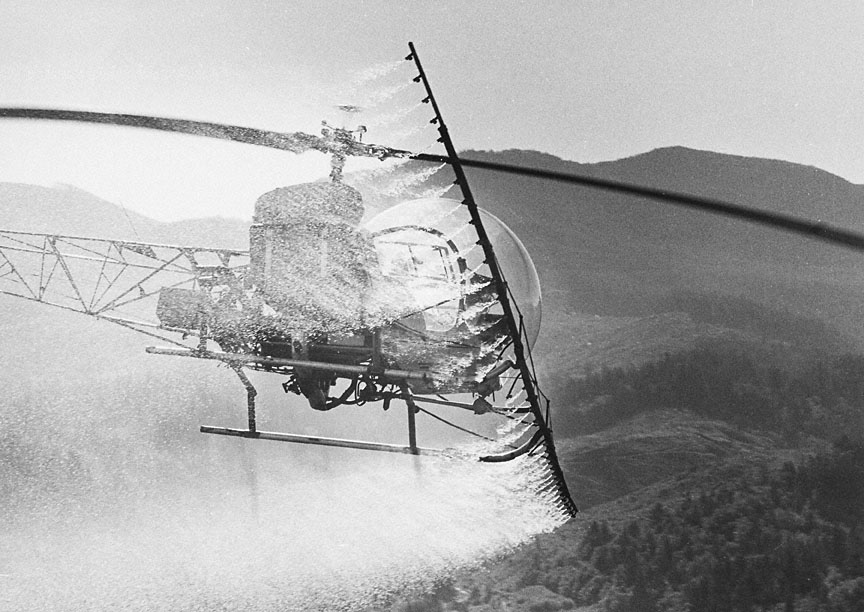- Catalog No. —
- OrHi 104979
- Date —
- March 1, 1979
- Era —
- 1950-1980 (New Economy, Civil Rights, and Environmentalism)
- Themes —
- Environment and Natural Resources, Transportation and Communication
- Credits —
- Oregon Folklife Program
- Regions —
- Coast
- Author —
- Dana Olsen, Oregon Journal Collection
Helicopter Sprays Chemical Herbicide
This photograph, by Dana Olsen, originally appeared on the front page of the Oregon Journal as an illustration for an article titled, “Miscarriages Bring Herbicide Ban.” The unprecedented “emergency action” to ban the herbicide, 2,4,5-trichlophenoxy acetic acid (2,4,5-T), from use in forestry and grazing operations and right-of-way maintenance for power lines and highways, was ordered by the U.S. Environmental Protection Agency after a six-year study by the University of Colorado. The study had identified a reoccurring, mid-summer peak in miscarriages in Alsea, Oregon and related them to the spring spraying of the chemical in forestry operations. Scientists associated with forestry and chemical industries immediately contested the sampling methods used for the study. They have also continued to decry the regulation of the chemical, claiming that its benefits far outweigh any damages it causes.
The use of helicopters in forestry operations dates to the unprecedented reforestation efforts undertaken by the state of Oregon in the wake of the Tillamook Burn, a series of massive forest fires that raged across the coastal forests of northwest Oregon in 1933, 1939, 1945, and 1951. Helicopters were fitted with seed-dispersing hoppers, distributing douglas fir seed across 97,679 acres from 1949 to 1970. To deter mice and birds from eating the seeds, they were laced with endrin, an organochlorine chemical, similar to DDT, banned for use in the United States in the early 1970s. Even so, “broadcast seeding” of douglas fir trees proved to be largely unsuccessful. Fast-growing, naturally occurring brush and alder trees quickly overgrew the commercially prized firs.
Over time, helicopters have increasingly been utilized by industrial foresters to apply pesticide and herbicide chemicals to clearcut landscapes and monoculture tree plantations. Moreover, as technological enhancements in helicopter design and construction improved their hauling capacity, they have also provided logging companies with the means to cut trees on steep slopes that were previously inaccessible. Helicopters have also been used for “timber cruising” and road surveying, fertilizing, mapping, fire patrols, backcountry transportation, and photography.
Further Reading:
Rajala, Richard A. Clearcutting the Pacific Rain Forest: Production, Science, and Regulation. Vancouver, B.C., 1998.
Carson, Rachel. Silent Spring. Greenwich, Conn., 1962.
Colborn, Theo, Dianne Dumanoski, and John Peterson Myers. Our Stolen Future: Are We Threatening Our Fertility, Intelligence, and Survival?: A Scientific Detective Story. New York, N.Y., 1996.
Written by Joshua Binus, Oregon Historical Society, 2003.
